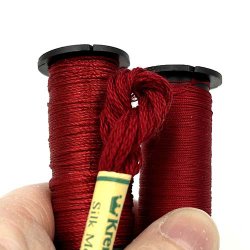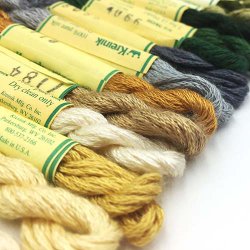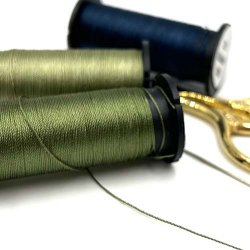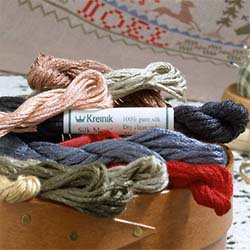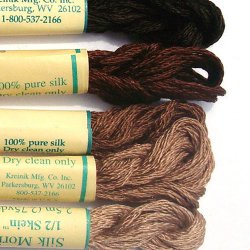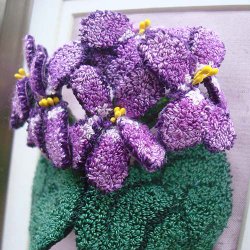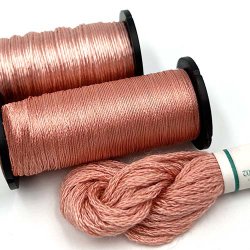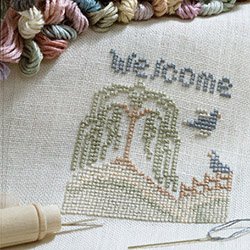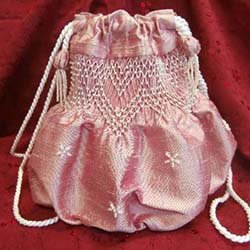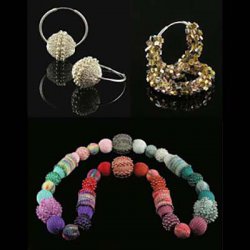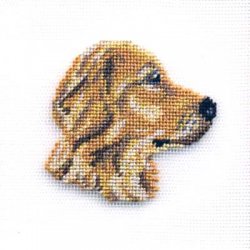Silk Thread
Tips and ideas for using Kreinik silk threads.
-
Kreinik Silk Thread Widths
Jewelry makers and other fiber artists often choose thread by their width. Whether you’re working with wire, beads, needles, or general crafts, now you can choose the right Kreinik thread width for your project.
mm means millimeter
KREINIK THREAD NAME + WIDTH
Silk Mori, one strand 0.4mm
Silk Mori Milkpaint, one strand 0.4mm
Silk Mori is a floss, comparable to DMC or Anchor Embroidery floss in size
Silk Serica .34mm
Silk Serica is a twisted silk, comparable to a DMC #3 or #5 Pearl Cotton in size
Silk Bella .21mm
Silk Bella is a thin twisted silk, comparable to a DMC #12 Pearl Cotton in size
-
How to use Kreinik Silk Serica®
Silk Serica® can be used as is, straight from the reel, as a 3-ply twisted filament silk. It can also be separated and used as a flat silk. Made of 100% pure filament silk, the sheen is so rich and bright, it instantly turns any design into a work of art. Perfect in heirloom projects and designs focusing on different textures.
The most important tip to remember when working with Silk Serica: moisturize your hands with a non-greasy hand cream. This will keep the filament silk from snagging on rough spots.
See Description below for more tips and usage ideas.
-
How to use Kreinik Silk Mori®
Kreinik Silk Mori® is a 6-strand spun silk. That means:
- as a spun silk, it has a creamy natural luster (as opposed to a filament silk, which has a bright sheen)
- you can separate the strands and recombine to suit whatever your stitch is on whatever fabric or canvas you're using—two strands of Silk Mori is ideal for cross stitch on 14-count Aida, for instance.
- you can use it in place of cotton embroidery floss, when you want to elevate a design (creating an heirloom), when you want to show off the beautiful natural sheen of silk (like in samplers), or simply when you want to spoil your eyes and your fingers (it's so soft!)
Read the Description below for stitching tips and usage ideas for Kreinik Silk Mori.
-
How to use Kreinik Silk Bella™
Silk Bella™ is the thinnest of the Kreinik silk threads. It is a filament silk with a bright sheen, visible in designs even with it's small weight. It is a beautiful thread when used in any stitch, in any technique. Silk Bella is dyed in colors to match Silk Mori® and Silk Serica®.
Content: 100% pure filament silk
Care
Silk Bella should only be dry cleaned. Do not wash or wet block silk work. Do not use an embroidery hoop with silk thread in hand stitchery, as the rings, markings or folds left in the fabric cannot be removed by washing the piece. Instead, use stretcher bars, Q-snaps, or scroll frames.
Applications
Appliqué (hand and machine), blackwork, costume making, crazy quilting (hand and machine), crewel, crochet, cross stitch/counted thread, couching, doll making (hand or machine), hardanger, Japanese embroidery, knitting, lace making, machine embroidery/bobbin work, machine embroidery/couching, miniatures, needlepoint/canvas work, punch embroidery, ribbon embroidery (hand and machine), smocking, stumpwork, weaving.
Hand Embroidery, Cross Stitch, Samplers, Needlepoint
Silk Bella is ideal for a variety of stitches in samplers, hardanger, crewel, stumpwork, pulled work, crazy quilting, petit point, and needlepoint or canvas work. Use it straight from the reel as a 3-ply twisted thread for tent stitch, satin stitch, kloster blocks and other stitches that showcase its texture. It is similar in weight to a #12 Pearl Cotton. Do not separate strands; use as is, straight off the reel.
Tips on using Silk Bella
- To keep your stitching looking its best, take time to wash your hands before stitching. Use a non-greasy hand cream to moisturize hands and prevent the silk from snagging on dry skin or cuticles.
- Prepare your ground material (fabric or canvas) prior to stitching to prevent the silk from snagging on rough edges. Turn the edges under with a running stitch, or cover the edges with tape.
- Silk Bella® comes on a snap-spool mechanism. Both sides of the spool open; look for the side where the thread end is located. Insert your thumbnail under the cap, and rotate the spool while gently lifting the cap to release the thread (the cap should not pop off). Snap the lid shut to secure the unused portion.
- Use lengths of silk no longer than 45cm (18 inches) for better thread control and reduced thread abrasion from repeated passes through the ground material. Use a needle large enough to 'open' the hole in the fabric to allow the silk thread to go through easily.
- It is important to maintain Silk Bella's twist as it comes from the spool to ensure uniform stitches from beginning to end. Since all of us as stitchers twist our needles a little bit while stitching, apply a slight reverse twist to your needle, or allow your needle to dangle every one or two stitches. This will prevent the softly twisted silk from untwisting or becoming too tightly twisted.
-
Silk Thread History
Since it was first processed in China, silk thread has been used in embroidery for more than 5,000 years. Silk is an animal fiber made from the viscous fluid of the silkworm. Originally, silkworm cocoons were collected from trees. In 2640 B.C., a Chinese Empress discovered that if a silk cocoon was placed in hot water to soften the natural glue or sericin (holds the cocoon together), then a silk cocoon could be unwound and stretched into a long filament. Fo Xi, China's first Emperor, taught the Chinese people to cultivate mulberry trees and raise silkworms.
The first variety of silkworm to be domesticated was the Bombyx Mori. Over the centuries, at least thirteen other species have been cultivated. In addition, there are more than 80 varieties of wild silkworms. In the history of needlework, silk was a primary thread for embroidery, used in tapestries and garments, blackwork, and samplers. When the world was at war in the beginning of the 1940's, however, the silk supply literally dried up overnight. Chemical companies developed synthetic fibers commercially, and these fibers replaced silk almost instantly. As a result, for more than fifty years, people have looked upon silk as rare, expensive and delicate.
Today, embroiderers acknowledge silk for its practical and lustrous qualities. The translucent cellular structure of silk allows it to absorb dyes and to reflect light to a high degree, giving the finished product a pure color and a beautiful luster. When worked in specialty stitches and laid properly, silk has a bright sheen unrivaled by other threads. Due to the different cellular structures of silk and cotton, for example, silk is very smooth while cotton is fuzzy.
Silk also remains lustrous and strong over time, while cotton loses its luster and strength. Archaeologists found that silk in China, buried in tombs for 3,000 years, was the only fiber that remained intact and recognizable. Also, in Sweden, while dredging a channel in the harbor where an old warehouse had burned, black silk skeins buried under mud for 27 years were discovered. After cleaning, they found that the color, strength, and lustre still remained.
Choose silk thread for its unparalleled lustre, texture, and elegance. It adds a richness that raises your needlework to a higher level. Whether used in sampler work, needlepoint, or other techniques, silk threads enable needleworkers to play with light and with textures in their stitchery. It is an affordable thread that is perfect for treasured, keepsake needlework. Its softness, too, makes silk the ultimate in luxurious stitching enjoyment.
-
Alternate skin color choices
Personalize a design by stitching faces and bodies in particular skin tones. The following are suggestions for popular "flesh" color choices and hair color choices of Kreinik Silk Mori®. Explore the whole palette of Mori colors for more variations in skin tones.
African-American:- palest shade - 7133 Light Bark
- light shade - 7134 Medium Bark
- medium shade - 7135 Medium Dark Mocha
- lightest hair shade - 7136 Dark Mocha
- medium hair shade - 7166 Dark Brown Black
- dark hair shade - 8050 Black
Asian:
- palest shade - 0903 Light Cinnamon
- light shade - 0743 Light Oystershell
- medium shade - 0724 Medium Wheat
- lightest hair shade - 7136 Dark Mocha
- medium hair shade - 7166 Dark Brown Black
- dark hair shade - 8050 Black
Hispanic:
- palest shade - 0704 Medium Buttermilk
- light shade - 0903 Light Cinnamon
- medium shade - 7024 Antique Parchment
- lightest hair shade - 7136 Dark Mocha
- medium hair shade - 7166 Dark Brown Black
- dark hair shade - 8050 Black
Caucasian:
- palest shade - 3021 Sherbet
- light shade - 9032 Lightest Neutral Flesh
- medium shade - 9034 Medium Neutral Flesh
-
Punchneedle Selection Chart
There are three basic needles used for the punchneedle embroidery technique: 1-strand, 3-strand, and 6-strand needles. This chart matches Kreinik threads for punchneedle with the proper punchneedle size:

-
Silk Thread Conversion Charts
Convert designs from cotton floss or other threads to Kreinik silk threads. Click on one of the links below to view and print our silk thread conversion charts.
Find the closest match for DMC to Kreinik Silk Mori®
DMC Cotton Floss to Kreinik Silk Mori® Conversion ChartFind the closest match for Anchor to Kreinik Silk Mori®
Anchor Cotton Floss to Kreinik Silk Mori® Conversion ChartFind the closest match for Pearsalls Silk to Kreinik Silk Mori®
Pearsalls Silk to Kreinik Silk Mori Conversion ChartFind the closest match for Soie d'Alger to Kreinik Silk Mori®
Soie d' Alger Floss to Kreinik Silk Mori® Conversion ChartFind the closest match for Pearl Cotton to Kreinik Silk Serica®
Pearl Cotton to Kreinik Silk Serica® Conversion ChartFind the closest match for Pearl Cotton to Kreinik Silk Bella™
Pearl Cotton to Kreinik Silk Bella™ Conversion Chart -
How to pick a primitive color palette
Have you been thinking about using silk threads for a sampler? It is a good choice; silk was the thread most often used in sampler stitching over the last few centuries. It is strong, easy to use, and has a beautiful sheen.
Kreinik Silk Mori (a floss), Silk Serica (a pearl-cotton-size), and Silk Bella (a super-fine size) are three different weight, or sizes, of silk thread available from Kreinik. You can get them on standard sized spools or large cones/skeins. They come in more than 175 colors. To some, 175 colors may not sound like enough. To others, especially those just starting to use silk, it's overwhelming. No problem; here we will show you how to get started:
- If you're new to stitching with silk, start with Kreinik Silk Mori. It's a floss, similar to cotton embroidery floss, and very easy to use. We will focus on Silk Mori in this article.
- Get a silk color card and use it to match silk colors to an antique sampler. Then once you have your list, you can order just what you need.
- OR, pick a starter thread assortment like one of our Silk Home Decor Collections. You get a small collection of silk colors with minimal investment. The "antique" set is particularly synonymous with the primitive look, but you can also go with a brighter group if you prefer.
- Narrow the 175 down to primitive, shaker, antique, or "sampler" style colors (see the list below) Print a copy and keep it handy for checking off your stash purchases.
- Look for "half-skeins", or 2.5-meter skeins to start your collection. Half-skeins are cheaper, have about 3 yards of silk in each skein, and are a nice way to start a collection.
- The Milkpaint collection of Silk Mori is made up of primitive colors, designed to replicate the milk paint popular during colonial times. These colors aren't listed below, but you can find them on this website. All of the Milkpaint color range (the color numbers begin with "0" as in 0104.
- Choose the colors listed below in Silk Mori for cross stitch, applique, and hand embroidery:
- 1093 Light Wood Violet
- 1094 Medium Wood Violet
- 1096 Dark Wood Violet
- 1098 Wood Rose
- 1119 Garnet
- 2014 Medium Gold
- 2016 Dark Gold
- 2017 Very Dark Gold
- 3063 Light Henna
- 3065 Dark Henna
- 4074 Medium Dusty Green
- 4076 Dark Dusty Green
- 4077 Very Dark Dusty Green
- 4203 Light Sage
- 4204 Medium Sage
- 4206 Dark Sage
- 4212 Lightest Avocado
- 4215 Medium Dark Avocado
- 4216 Dark Avocado
- 5057 Very Dark Slate Blue
- 5107 Very Dark Cerulean
- 6123 Light Dusty Lavender
- 6124 Medium Dusty Lavender
- 6216 Dark Dusty Lavender
- 6127 Very Dark Dusty Lavender
- 6204 Medium Dusty Plum
- 6205 Dark Dusty Plum
- 6207 Very Dark Dusty Plum
- 7012 Lightest Lead Grey
- 7014 Medium Lead Grey
- 7024 Antique Parchment
- 7025 Parchment
- 7086 Dark Straw
- 7087 Very Dark Straw
- 7126 Ecru
- 7134 Medium Bark
- 7135 Medium Dark Mocha
- 7136 Dark Mocha
- 7166 Dark Brown Black
- 7173 Light Honey
- 7174 Medium Honey
- 7175 Medium Dark Honey
- 7183 Light Sable
- 8050 Black
- 8075 Medium Dark Charcoal
- 8077 Very Dark Charcoal
- 8086 Dark Gray
Don't be intimidated by silk threads; stitchers have been using it successfully for centuries. Your fingers will be spoiled by its softness, your mind will be impressed at its strength and durability, and your eyes will delight at the beautiful, natural sheen. For the price of a small skein of silk, it's worth a try.
-
Can you use silk threads in smocking?
Silk is a fabulous thread to work with in any needlework technique, and there are many reasons silk has been used in needlework for centuries. It is durable, strong, and takes dyes on a deeper cellular level than any other fiber (that means you get really rich, gorgeous colors). Today silk is used in everything from fly fishing to knitting, needlepoint, cross stitch, weaving, and smocking.

Remember smocking? It's back. Once England's Prince George wore his cute little smocked jumper on his visit to Australia as an infant, smocking was back in style. Smocked sundresses are a staple in little girls' fashion, but fashion-forward children aren't the only ones wearing the style. Vintage-inspired embroiderers are embracing smocking for everything from wedding dresses to home decor and handbags. "I am on a campaign to get the word out that smocking is so much more than children's clothing," says smocking teacher Barbara Meger.
From the Middle Ages onward, smocking has been an embroidery technique with pretty but practical virtues. It may look like simple elastic-like pleating, but the sculpting effects, embroidery stitches and eye-catching patterns make smocking extraordinary. The most popular threads in smocking are cotton and silk, but you can use other threads as well—Kreinik metallic threads too!
The photos shown here are designs from Barbara's company, Classic Creations. This smocking and bead embroidery bag is created with Kreinik Silk Bella, a 100% pure very thin, fine silk thread. The design is called "Beaded Van Dyke Reticule." You can find many of Barbara's smocking patterns online (search her name or company name), as well as many other smocking patterns. Substitute Kreinik silk threads, and your beautiful embroidery will be instant heirlooms.
-
How to use silk & metallics in bead knitting & bead crochet
You may not think that the thread shows much in beading, or matters much, but it does. We asked designers what they thought of Kreinik threads, and they offered helpful tips to share with you. Whether you're getting into bead crochet, bead knitting, surface embroidery, or other types of beadwork, Kreinik metallic and silk threads offer some benefits that you just can't get with other threads, such as:
1. 200+ colors from which to pick — "For beaded embroidery, the thread color should match the fabric or the beads," notes designer Kim Kotary. With the large range of Kreinik shades, you can find a color to match any bead.
2. Did we mention 200+ colors: With such a wide range, you have more complementary color choices when working a design where the thread shows around the beads. "Kreinik threads are SO PRETTY," says designer Vashti Braha.

Bead Stew "Fire Walk with Me" by Earth Faire 3. Metallics add elements of light to designs — "it catches the light" says designer Maria del Pinto, and it complements the color depth of dichroic and Venetian glass beads, for instance. "Metallic threads add a wonderful shimmer to the beaded knit," notes designer Brenda Franklin. She adds that a transparent bead on a metallic thread will have the shimmer and glow you look for in a silver-lined beads (lined beads often have smaller holes and lose their glow). Designer Betsy Hershberg says Kreinik Cable in particular "is a great choice for a true metallic jewelry look."
4. Kreinik metallic braids, cables, and ribbons are strong: Brenda Franklin notes in her book Beaded Knits Vol. 1 that "glass beads add weight, so the thread that is used for beaded knits must be able to support this extra weight." Brenda often uses Kreinik #8, 12 and 16 Braids for her projects. Vashti Braha uses the metallics "when I need just the right way to feature a dichroic glass pendant. Kreinik stands up to the kind of metallic color depth, and the sheer weight of the glass pieces."

Reversible Bracelet by Brenda Franklin 5. Kreinik silk threads are strong. Silk is natural and one of the strongest fibers you can find. Betsy Hershberg had this to report after trying Kreinik Silk Serica for projects in her book, Betsy Beads: "The silk is a joy to knit/bead with. I'm not sure if I can accurately describe one of its favorite qualities for me as a knitter, but it has to do with a certain amount of "stickiness" it has that allows it to hold for a very even tension i.e., the stitches stay the same size rather than slipping as a rayon thread might. And don't even get me started on the color range..... I am thrilled to have discovered it." About Silk Serica, she adds, "I just love the sheen and the hand of the silk and it stands up really well to the friction of being strung with quite small beads. The stitch definition is beautiful. And it is SO strong!"
6. Kreinik threads are flexible, won't kink: From Earth Faire, a bead and jewelry kit company, "These are very easy threads to use -- unlike most metallics, I haven't found in these a tendency to kink -- they lie smoothly and work well with just about all of the size beads that we use."
7. Kreinik metallics are hand and machine washable: Cotton threads tend to stretch, but with the Kreinik metallics, "stretching when wet is not an issue," notes Earth Faire.
8. They come in a variety of weights/sizes: About Kreinik Tapestry #12 Braid, for example, Vashti notes, "This thread seems to bridge sizes #10 and #20 cotton threads." Kreinik has six sizes of metallic braid, two sizes of metallic ribbon, and three sizes of silk thread, which means you can pick from several options to either match bead sizes or to create your own yarn/thread by combining with other thread types. Some of the thinner threads, like Kreinik Blending Filament and Very Fine #4 Braid work well as carry-along fibers.
9. You can get thread in a variety of spool sizes: Since Kreinik makes their own threads, we can spool or cone any amount. Working on a large project, for instance? Choose a 50m cone, or special-order a custom size. The standard Kreinik spool sizes - from 10m to 20m on a spool — are ideal amounts for most jewelry projects.
Examples of what you can make
- Beaded earrings
- Beaded brooches
- Beaded necklaces
- Beaded ornaments
- Beaded pendants
- Beaded purses
- Beaded socks
- Beaded embroidery
- Beaded trim for garments, home decor, fashion accessories
Which threads to use
METAL/STEEL HOOKS AND NEEDLES:
Consensus among bead knitters/crocheters is that metal hooks and needles work better than plastic or wooden ones. From designer Maria del Pinto: "You need a metal crochet hook because the plastic ones have surfaces that catch the threads which can ruin the finished look of a piece." Gwen Blakley Kinsler, founder of the Crochet Guild of America, adds, "Depending on the thread, I use a steel hook, sizes 6, 7 or 8."
KREINIK METALLIC THREADS:
- Fine #8 Braid is great for crochet and fine needle lace work, and works well with size 11 seed beads.
- Fine #8 Braid is frequently used by Earth Faire for beaded jewelry: "We have been using this thread with many of the Jewelry patterns from Brenda Franklin (see their "Jewelry Creations" on www.earthfaire.com web page). The color and sheen is fabulous and the hand as one works with it is extremely pleasing."
- Tapestry #12 Braid is another favorite: "it is slightly heavier than the Fine Braid but we like its strength and it works with all but the tiniest of beads (and even sometimes with those)," notes the team at Earth Faire.
- Medium #16 Braid: "Very firm knit structure, very strong braid that will support larger beads well," reports bead knitting designer Brenda Franklin. Some of the high lustre colors can be rough against skin, however.
- Heavy #32 Braid and the 1/8" Ribbon are thicker metallics, both equivalent to a fingering/sock yarn, a Light Sport Weight and a size #5 cotton crochet thread, according to Vashti. Beads: "6/0 E-beads" aka "large seed beads" work with this size, but these thicker threads can be rough against skin.
- Blending Filament is a soft, thin, tinsel-like thread. Rather than using the filament to string beads, we recommend that you use filament as a carry-along thread, worked with another thread type at the same time. It will add a subtle metallic shimmer.
- Fashion Twist and Fine Twist: These two Kreinik Machine Sewing Metallic Threads are thin enough to use as a carry-along thread in bead knitting and crochet. They are strong, but also anti-microbial, offering added hygienic qualities for beaded garments. See the HeartStrings Fiber Arts knitting pattern #S33 "Glitz and Beads Socks" here: http://www.
heartstringsfiberarts.com/s33. with video tutorial here: http://jackie-es.com/the-shtm designing-day/a-fashion-twist- with-kreinik-metallic.php

Spyro Gyro earrings by Brenda Franklin KREINIK SILK THREADS:
- Silk Bella: "Wow, this is like tatting thread," notes Vashti, ".5mm hook seems just right. I guess equiv. to #40 or #50 crochet thread."
- Silk Serica creates soft but strong stitches. "Silk Serica is fabulous with the beads," notes Gwen, "size 8 or 10 or larger [bead] is recommended because it [Serica] is thicker."
- Silk Serica or Silk Bella offer a smooth thread for handling delicate beads like pearls.
- Silk is a natural animal fiber, so silk thread complements creations with natural stones.
BEADS:
- pearls
- natural stones
- semi-precious stones
- glass: dichroic, Venetian, Czech, Delica, seed beads
- crystal beads, Swarovski and other
- sterling silver, gold, gold-filled, metal beads
- bugle beads
Where to get more information or inspiration
BOOKS:
- Betsy Hershberg, Betsy Beads, XRX Books
- "Kreinik threads could be used in place of any others these authors recommend," notes Gwen Blakely Kinsler: Bethany Barry's book, "Bead Crochet" Interweave 2004, Susan Lutz Kenyon, "Beaded Beauties to Crochet" by Leisure Arts, 2004, "Crochet with Beads" by Hazle Shake , Design Originals,2 005, Lily Chin, "Knit and Crochet with Beads"
- Brenda Franklin, "Beaded Knits Jewelry and Accessories" volumes 1, 2 and 3.
- Beading on Fabric by Larkin Jean Van Horn from Interweave Press
-
How to stitch on silk gauze
Silk gauze is a 100% pure filament silk canvas. The silk threads are fine but very strong. Silk gauze is woven in a leno structure, which increases the stability of the canvas. Leno weave actually interlocks the weft threads making it almost impossible for them to shift.
When to stitch on silk gauze?Stitch on fine counts of silk gauze anytime you want a small, delicate piece of needlework. Miniaturists and doll house enthusiasts enjoy silk gauze needlepoint pieces because you can achieve realistic looking items. For example, doll house rugs, pillows, pictures, and bell pulls can be stitched to scale: 40-count silk gauze is perfect for 1-inch to 1-foot scale.
Silk gauze work is also popular among needlepointers looking for something different to stitch on or for making detailed embroidery like jewelry.
How do you stitch on silk gauze?The first step in stitching on silk gauze is choosing a project. Almost any charted cross stitch design can be used for silk gauze needlepoint. Designs without quarter stitches, blended colors, backstitches, or elaborate color changes make the most successful silk gauze needlepoint projects. You stitch over one thread on silk gauze.
Continental (or tent) stitch is the appropriate stitch for silk gauze because it makes for a smooth, even silk gauze needlework. Also, it is easier to stitch tent through such petite holes. The use of tent stitch, for example, will have a maximum of two threads in a hole whereas cross stitch could have as many as four stitches per hole. Generally, you stitch with silk threads on silk gauze.
Stitching tipsSharp scissors, good lighting, and magnifiers can make stitching on silk gauze a breeze. Starting at the top of a chart makes it easier to keep your place on the chart while stitching. A magnet board will also help, or simply cross out stitches on the chart that have been completed as you go along.
Choosing the appropriate needle for silk gauze is also important, as using a needle that is too large can distort the canvas. Kreinik’s silk gauze kits and framed silk gauze includes a needle.
When stitching on silk gauze, a neat back is especially important if some of the background is left unstitched. When starting a thread, try to use an ‘away waste knot’ to begin. You may sometimes be able to end a thread using this same technique, resulting in less bulk on the back of your work. When ending threads by ‘running’ under stitches, use caution so that the tension of the stitches is not changed.
A dark piece of cloth behind your work makes the holes of the silk gauze ‘pop’ and you can see the threads that need to be covered.Needle sizes for silk gauze
gauze count — needle size — Kreinik thread to use for tent stitch or half-cross- 18-count — #20 Tapestry Needle — 6 strands of Silk Mori; Canvas #24 Braid or Medium #16 Braid; 1/16" Ribbon
- 20-count — #22 Tapestry Needle — 5 strands of Silk Mori; Medium #16 Braid or Tapestry #12 Braid; 1/16" Ribbon
- 28-count — #26 Tapestry Needle — 2 strands of Silk Mori; Fine #8 Braid; 1/16" Ribbon
- 30-count — #26 Tapestry Needle — 2 strands of Silk Mori; Fine #8 Braid
- 32-count — #28 Tapestry Needle — 2 strands of Silk Mori, 1 strand of Silk Bella, Fine #8 Braid or Very Fine #4 Braid
- 34-count — #28 Tapestry Needle — 1 strand of Silk Mori, Silk Bella, Very Fine #4 Braid
- 35-count — #28 Tapestry Needle — 1 strand of Silk Mori, Silk Bella, Very Fine #4 Braid
- 40-count — #28 Tapestry or #10 Crewel — 1 strand of Silk Mori, Silk Bella, 1 strand of Blending Filament
- 42-count — #28 Tapestry or #10 Crewel — 1 strand of Silk Mori, Silk Bella, 1 strand of Blending Filament
- 49-count — #10 Crewel — 1 strand of Silk Mori, Silk Bella, 1 strand Blending Filament
- 50-count — #10 Crewel or #12 Beading — Blending Filament, Cord
- 54-count — #10 Crewel, #12 (Sharp or Beading) — Cord
- 60-count — #12 (Crewel, Sharp or Beading)
- 84-count — #12 (Crewel, Sharp or Beading)
- 90-count — #12 (Crewel, Sharp or Beading)
Availability of silk gauzeSilk gauze can be purchased in several ways:
1. Kreinik mounts silk gauze on mat board, which acts as a frame while stitching or as a mat for the finished piece. This is an economical way to purchase gauze, and various sizes are available. The framed silk gauze from Kreinik comes with a needle, so you are immediately prepared to start stitching.
2. Purchasing silk gauze by the yard will enable you to stitch pieces larger than that allowed with pre-mounted pieces. The silk gauze should then be mounted on a frame or stretcher bars for stitching.
3. Kreinik offers silk gauze in several different counts such as 20-count, 32-count and 40-count. The higher the number, the smaller the canvas "holes".
Stitching with silk gauze can be very rewarding. The detailed needlework that you complete will be admired by many.



